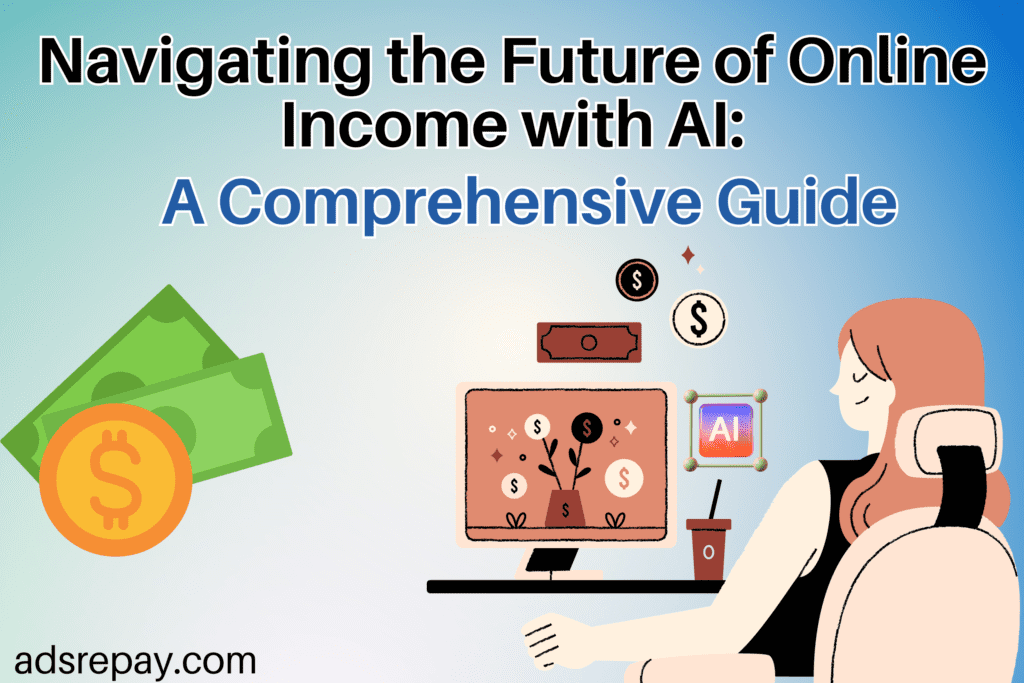Introduction:
In an era driven by technological advancements, the integration of artificial intelligence (AI) into various sectors has revolutionized the way we live and work. One significant aspect of this transformation is the evolution of AI-powered online income opportunities. From freelance gigs to automated trading, AI is reshaping the landscape of earning potential on the internet. In this comprehensive guide, we’ll delve into the future of online income with AI, exploring its various facets and providing insights for individuals seeking to leverage these opportunities.

1. Defining Artificial Intelligence: An Overview
Artificial Intelligence (AI) is the replication of human intelligence in machines, empowering them to undertake tasks that traditionally demand human cognitive capacities. These tasks include learning, problem-solving, perception, reasoning, and decision-making. AI systems utilize algorithms and vast amounts of data to recognize patterns, make predictions, and improve their performance over time.
Types of AI:
1. Narrow AI, also termed Weak AI, is engineered to execute precise tasks confined to a limited domain. Examples include virtual assistants, recommendation systems, and image recognition software.
2. General AI: Also referred to as Strong AI, it possesses human-like cognitive abilities and can understand, learn, and apply knowledge across diverse tasks and domains. General AI, still a theoretical concept, has yet to be realized.
3. Applications of AI:
Natural Language Processing (NLP): Understanding and processing human language, enabling applications like chatbots, language translation, and sentiment analysis.
4. Machine Learning (ML): Algorithms that allow computers to learn from data and make predictions or decisions without being explicitly programmed. Common techniques include supervised learning, unsupervised learning, and reinforcement learning.
5. Computer Vision: Analyzing and interpreting visual data, used in image recognition, object detection, and autonomous vehicles.
6. Robotics: Integrating AI with robots to perform tasks such as assembly line operations, healthcare assistance, and exploration in hazardous environments.
1.2. The Evolution of AI in Online Income Generation
The integration of AI into online income generation has undergone significant evolution, driven by advancements in AI technologies and the proliferation of digital platforms. Key milestones include:
Early Adoption: Initially, AI was primarily utilized in large-scale enterprises for data analysis, customer service automation, and predictive modeling.
Expansion into Online Platforms: With the rise of internet-based businesses, AI found applications in online advertising, content recommendation, and user behavior analysis.
The emergence of AI-driven Marketplaces: Platforms like Upwork, Fiverr, and Amazon Mechanical Turk leverage AI algorithms for matching freelancers with clients, automating tasks, and ensuring quality control.
Personalization and Customer Experience: E-commerce giants such as Amazon and Alibaba employ AI for personalized product recommendations, dynamic pricing, and customer service chatbots.
Financial Trading and Investments: AI algorithms are increasingly used for algorithmic trading, portfolio management, and risk assessment in financial markets, enabling individuals to generate income through automated trading strategies.
1.3. Impact of AI on Traditional Income Streams
The adoption of AI has disrupted traditional income streams while creating new opportunities for individuals:
Automation of Routine Tasks: AI-powered automation reduces the need for manual labor in repetitive tasks, impacting jobs in industries like manufacturing, retail, and customer service.
Upskilling and Reskilling: Individuals are encouraged to acquire new skills and adapt to emerging technologies to remain relevant in the job market. AI-related skills such as data analysis, programming, and machine learning are in high demand.
Creation of New Income Opportunities: AI enables individuals to monetize their expertise through online platforms, freelance work, content creation, and e-commerce ventures.
Enhanced Efficiency and Productivity: Businesses leverage AI to streamline operations, improve efficiency, and deliver better products and services, leading to economic growth and increased income potential for workers.
In summary, AI is reshaping the landscape of online income generation by introducing automation, personalization, and efficiency enhancements, transforming traditional job roles and creating new avenues for earning income in the digital economy.
2. Emerging Trends in AI-driven Online Income
2.1. Gig Economy 2.0: AI-powered Freelancing Platforms
The gig economy has experienced a transformative shift with the integration of AI, leading to the emergence of Gig Economy 2.0. AI-powered freelancing platforms leverage algorithms to match freelancers with projects, automate administrative tasks, and ensure quality control. Key features include:
Smart Matching Algorithms: AI algorithms analyze freelancer profiles, project requirements, and past performance data to facilitate precise matching, improving project outcomes and client satisfaction.
Automated Task Management: AI streamlines project management tasks such as time tracking, invoicing, and communication, enabling freelancers to focus on delivering high-quality work.
Skill Development Recommendations: AI-powered platforms offer personalized recommendations for skill development based on freelancers’ performance data and industry trends, empowering them to enhance their expertise and competitiveness.
Quality Assurance and Feedback Analysis: AI algorithms monitor project progress, analyze client feedback, and identify areas for improvement, fostering continuous learning and professional growth among freelancers.
2.2. Content Creation and Curation with AI
AI technologies are revolutionizing content creation and curation processes, enabling individuals to generate income through various digital media channels. Key trends in AI-driven content creation include:
Automated Content Generation: AI-powered tools generate high-quality content, including articles, blog posts, social media posts, and product descriptions, based on user-defined parameters and preferences.
Content Personalization: AI algorithms analyze user data, preferences, and behavior to deliver personalized content recommendations, increasing user engagement and retention on digital platforms.
Content Optimization: AI tools optimize content for search engines (SEO), social media platforms, and other digital channels, improving visibility and driving organic traffic to websites and online content.
Multimedia Generation: AI technologies create multimedia content, including images, videos, and audio files, enhancing storytelling and audience engagement across diverse digital platforms.
2.3. AI-driven E-commerce: Personalized Shopping Experiences
E-commerce platforms leverage AI to deliver personalized shopping experiences, driving sales and revenue growth. Key trends in AI-driven e-commerce include:
Product Recommendations: AI algorithms analyze user behavior, purchase history, and preferences to generate personalized product recommendations, increasing conversion rates and customer satisfaction.
Dynamic Pricing: AI-powered pricing algorithms adjust product prices in real time based on market demand, competitor pricing, and other factors, optimizing revenue and profit margins for e-commerce retailers.
Virtual Try-On and Visualization: AI technologies enable virtual try-on experiences for apparel, cosmetics, and accessories, allowing customers to visualize products before making purchase decisions, reducing returns and enhancing the shopping experience.
Chatbots and Virtual Assistants: AI-powered chatbots provide real-time customer support, answer product-related questions, and facilitate transactions, improving customer engagement and reducing operational costs for e-commerce businesses.
2.4. Influencer Marketing 2.0: AI-enhanced Engagement Strategies
Influencer marketing has evolved with the integration of AI, enabling influencers to optimize engagement strategies and monetize their digital presence more effectively. Key trends in AI-enhanced influencer marketing include:
Audience Segmentation and Analysis: AI algorithms analyze influencer audiences’ demographics, interests, and behavior to identify niche markets and tailor content strategies accordingly, increasing engagement and brand affinity.
Content Optimization: AI-powered tools optimize influencer content for maximum reach and engagement across digital platforms, leveraging data-driven insights and A/B testing to refine content strategies
Performance Analytics: AI platforms provide real-time analytics and performance metrics, enabling influencers to track campaign effectiveness, measure ROI, and optimize content strategies based on audience feedback and engagement data.
AI-generated Content Collaboration: AI technologies facilitate collaboration between influencers and brands by generating content ideas, suggesting collaboration opportunities, and automating campaign management tasks, streamlining the influencer marketing process.
2.5. Cryptocurrency Trading Bots and AI Algorithms
The cryptocurrency market has witnessed the proliferation of AI-powered trading bots and algorithms, enabling individuals to generate income through automated trading strategies. Key trends in AI-driven cryptocurrency trading include:
Algorithmic Trading Strategies: AI algorithms analyze market data, price movements, and trading signals to execute buy/sell orders automatically, optimizing trading strategies and maximizing profit potential.
Risk Management and Portfolio Optimization: AI-powered trading bots employ risk management techniques, such as stop-loss orders and portfolio diversification, to mitigate losses and optimize investment returns in volatile cryptocurrency markets.
Sentiment Analysis: AI algorithms analyze social media, news articles, and other sources of market sentiment to gauge investor sentiment and predict market trends, informing trading decisions and strategy adjustments in real time.
Machine Learning-based Prediction Models: AI-driven prediction models leverage machine learning algorithms to forecast cryptocurrency price movements and identify profitable trading opportunities, enhancing decision-making and strategy optimization for traders.
In conclusion, the integration of AI into online income generation has led to the emergence of diverse opportunities across various sectors, including freelancing, content creation, e-commerce, influencer marketing, and cryptocurrency trading. By leveraging AI technologies and staying abreast of emerging trends, individuals can capitalize on these opportunities and unlock new avenues for earning income in the digital economy.
3. Opportunities and Challenges for Individuals
In the rapidly evolving landscape of AI-driven online income, individuals encounter various opportunities and challenges. Understanding and navigating these factors are crucial for maximizing potential earnings and ensuring sustainable growth.
3.1. Opportunities for Diversified Income Streams
Opportunity: AI empowers individuals to explore diverse income streams across multiple platforms and industries.
Freelancing Platforms: Offer opportunities for remote work in fields such as programming, design, writing, and digital marketing.
Content Creation: Individuals can monetize their expertise through blogging, podcasting, video creation, and social media content.
E-commerce: Selling products through online marketplaces or establishing independent e-commerce stores with AI-driven personalization.
Investments: Engage in algorithmic trading, cryptocurrency investments, or peer-to-peer lending platforms utilizing AI algorithms.
Consulting and Training: Provide expertise in AI-related fields through coaching, consulting, and online courses.
Challenge: Balancing time and effort across multiple income streams while maintaining quality and consistency can be demanding. Individuals must prioritize effectively and develop strategies for managing diversified income sources.
3.2. Overcoming Barriers to Entry: Skills and Resources
Opportunity: AI democratizes access to income opportunities, allowing individuals with diverse backgrounds to participate.
Skill Development: Online resources, courses, and tutorials allow individuals to acquire AI-related skills such as programming, data analysis, and machine learning.
Collaborative Platforms: Communities and forums facilitate knowledge sharing, networking, and collaboration among individuals with varying expertise levels.
Low-Cost Tools: Many AI tools and platforms offer free or affordable options, enabling individuals to experiment and develop projects with minimal financial investment.
Technical Complexity: Learning AI concepts and tools can be challenging, requiring dedication and persistence.
Resource Constraints: Limited access to high-speed internet, computing hardware, or paid training courses may hinder skill development.
Competition: The increasing popularity of AI-related fields results in a competitive job market and higher entry barriers for newcomers.
3.3. Ethical Considerations and Transparency in AI-driven Income
Opportunity: Ethical considerations present opportunities for individuals to differentiate themselves and build trust with consumers.
Transparency: Individuals can prioritize transparency in AI-driven processes, ensuring clarity about data usage, algorithmic decision-making, and privacy protections.
Fairness and Bias Mitigation: Addressing biases in AI algorithms and ensuring fairness in outcomes can enhance reputation and attract ethical consumers.
Social Responsibility: Engaging in socially responsible practices, such as using AI for positive social impact or supporting ethical AI initiatives, can resonate with socially conscious consumers.
Complexity: Understanding and navigating the complex ethical implications of AI technologies, including biases, privacy concerns, and algorithmic accountability.
Regulatory Compliance: Adhering to evolving regulatory frameworks and industry standards related to AI ethics and data protection.
Reputation Risk: Mishandling ethical issues can lead to reputational damage and loss of consumer trust, impacting income opportunities.
3.4. Balancing Automation with Human Creativity and Intervention
Opportunity: Combining AI automation with human creativity and intervention can unlock new income opportunities and enhance productivity.
Creative Collaboration: Collaborating with AI tools to augment creative processes in content creation, design, and marketing.
Personalization and Customization: Leveraging AI-driven insights to personalize products, services, and marketing campaigns for enhanced customer engagement and revenue generation.
Strategic Decision Making: Using AI analytics to inform strategic business decisions and optimize income-generating activities.
Challenge: Maintaining a balance between automation and human involvement requires:
Skill Integration: Developing skills to effectively integrate AI technologies into workflows while preserving human creativity and intuition.
Risk Management: Assessing the risks associated with AI automation, such as errors, biases, and unintended consequences, and implementing safeguards accordingly.
Adaptability: Remaining adaptable and responsive to changing market dynamics and technological advancements to optimize the balance between automation and human input.
In conclusion, individuals exploring AI-driven online income opportunities must navigate a landscape of diverse possibilities and challenges. By embracing opportunities for diversified income streams, overcoming barriers to entry through skill development and resource utilization, addressing ethical considerations transparently, and balancing automation with human creativity, individuals can unlock their full potential in the AI-driven economy.
4. Strategies for Success in AI-driven Online Income
Navigating the realm of AI-driven online income requires a strategic approach that encompasses skill development, branding, data utilization, networking, and adaptability. Here are key strategies to succeed in this dynamic landscape:
4.1. Skill Development and Continuous Learning in AI Technologies
Strategy: Invest in acquiring and honing skills relevant to AI technologies through continuous learning and practical application.
Online Courses and Tutorials: Enroll in reputable online platforms offering courses in machine learning, data analysis, programming languages (Python, R), and AI-related domains.
Hands-on Projects: Apply theoretical knowledge through hands-on projects, competitions, and real-world applications to build practical experience and portfolio.
Specialization: Focus on specific areas within AI, like natural language processing, computer vision, or reinforcement learning, and become proficient in these specialized domains.
Stay Updated: Keep abreast of the latest advancements, research, and trends in AI technologies through academic publications, industry blogs, and conferences.
4.2. Building a Personal Brand in the Digital Space
Strategy: Establish a strong online presence and personal brand to showcase expertise, credibility, and value proposition.
Content Creation: Produce high-quality content, including blog posts, videos, podcasts, and social media posts, showcasing expertise in AI-related topics.
Consistency and Authenticity: Maintain consistency in content delivery and communication style while being authentic and transparent with the audience.
Engagement and Networking: Actively engage with the online community, participate in discussions, and build relationships with peers, influencers, and potential clients.
Thought Leadership: Position oneself as a thought leader in AI by sharing insights, contributing to discussions, and offering valuable perspectives on industry developments.
Feedback and Adaptation: Solicit feedback from the audience, adapt to evolving trends, and refine the personal brand based on audience preferences and market demands.
4.3. Leveraging Data Analytics for Informed Decision Making
Strategy: Harness the power of data analytics to derive actionable insights and optimize income-generating activities.
Data Collection and Analysis: Collect relevant data from various sources, including user interactions, market trends, and performance metrics, and analyze them to identify patterns, trends, and opportunities.
Predictive Analytics: Utilize predictive modeling techniques to forecast trends, anticipate customer behavior, and optimize resource allocation and decision-making.
Experimentation and A/B Testing: Conduct experiments and A/B tests to evaluate different strategies, products, or content variations and optimize outcomes based on data-driven insights.
Data-driven Marketing: Tailor marketing campaigns, content strategies, and product offerings based on data-driven insights into customer preferences, demographics, and behavior.
Data Privacy and Security: Ensure compliance with data privacy regulations and implement robust security measures to protect sensitive information and maintain trust with customers.
4.4. Networking and Collaboration in AI Communities
Strategy: Foster connections and collaboration within AI communities to access resources, knowledge, and opportunities.
Online Forums and Groups: Join online communities, forums, and social media groups focused on AI, machine learning, data science, and related topics to connect with like-minded individuals, share knowledge, and seek advice.
Professional Associations and Events: Attend conferences, workshops, and meetups organized by professional associations, industry groups, and academic institutions to network with peers, experts, and potential collaborators.
Collaborative Projects: Participate in collaborative projects, hackathons, and open-source initiatives to gain hands-on experience, expand the network, and showcase skills and expertise.
Mentorship and Peer Learning: Engage in mentorship relationships with experienced professionals or offer mentorship to aspiring individuals, facilitating knowledge transfer and personal growth within the community.
4.5. Managing Risks and Adapting to Dynamic Market Changes
Strategy: Mitigate risks and embrace adaptability to navigate uncertainties and capitalize on emerging opportunities in the AI-driven economy.
Risk Assessment: Identify potential risks and vulnerabilities in AI-driven income activities, such as technological disruptions, regulatory changes, cybersecurity threats, and market volatility.
Contingency Planning: Develop contingency plans and risk mitigation strategies to minimize the impact of adverse events and ensure business continuity in the face of disruptions.
Agility and Flexibility: Maintain agility and flexibility in business operations, product/service offerings, and strategic decisions to quickly adapt to changing market dynamics and consumer preferences.
Continuous Innovation**: Foster a culture of innovation and experimentation, embracing new technologies, business models, and market trends to stay ahead of the curve and capitalize on emerging opportunities.
Resilience and Persistence: Cultivate resilience and persistence to overcome setbacks, failures, and challenges encountered along the journey of AI-driven online income generation, learning from experiences and persevering towards long-term success.
Incorporating these strategies into one’s approach to AI-driven online income generation can enhance competitiveness, resilience, and sustainability in the dynamic and evolving digital landscape. By continuously refining skills, building a strong personal brand, leveraging data analytics, nurturing networks, and embracing adaptability, individuals can maximize their potential for success and thrive in the AI-driven economy.
5. Future Outlook and Predictions
The future of AI-driven online income is poised for significant growth and transformation, driven by technological advancements, evolving market dynamics, and societal shifts. Here’s a glimpse into key trends and predictions shaping the future landscape:
5.1. AI’s Role in Shaping the Future of Work and Income Generation
Prediction: AI will continue to revolutionize the nature of work and income generation, leading to the emergence of new job roles, industries, and economic paradigms.
Automation and Augmentation: AI-driven automation will streamline routine tasks across industries, augmenting human capabilities and enabling individuals to focus on higher-value activities that require creativity, empathy, and strategic thinking.
Gig Economy Expansion: The gig economy will evolve further with the proliferation of AI-powered platforms, facilitating flexible work arrangements, remote collaboration, and access to global talent pools.
Skills Evolution: There will be a growing demand for AI-related skills, including data science, machine learning, AI ethics, and human-computer interaction, reshaping education and workforce development initiatives.
5.2. Integration of AI with Emerging Technologies: AR, VR, and Blockchain
Prediction: AI will increasingly converge with emerging technologies such as augmented reality (AR), virtual reality (VR), and blockchain, unlocking synergies and new possibilities for online income generation.
Enhanced Experiences: AI-powered AR and VR applications will revolutionize user experiences in e-commerce, gaming, entertainment, and education, creating opportunities for immersive storytelling, personalized interactions, and virtual commerce.
Blockchain Integration: AI and blockchain technologies will intersect to enable decentralized AI marketplaces, secure data sharing, and transparent AI algorithms, fostering trust, accountability, and fairness in AI-driven income generation.
Cross-Industry Innovation: The integration of AI with AR, VR, and blockchain will catalyze innovation across diverse industries, including healthcare, real estate, finance, and logistics, unlocking new revenue streams and business models.
5.3. Regulatory Frameworks and Policy Implications for AI-driven Income
Data Privacy and Security: Stricter regulations will be implemented to protect consumer data privacy, ensure algorithmic transparency and mitigate risks associated with AI-driven income activities, such as data breaches and algorithmic biases.
Ethical AI Standards: Regulatory bodies will establish guidelines and standards for ethical AI practices, including fairness, accountability, transparency, and bias mitigation, to promote responsible AI-driven income generation.
Labor Market Regulations: Policymakers will explore new regulations and social safety nets to address challenges related to job displacement, income inequality, and gig economy labor rights in the context of AI-driven work.
5.4. Societal Impact: Addressing Inequality and Access to AI-driven Opportunities
Digital Inclusion: Efforts will be made to bridge the digital divide and ensure equitable access to AI technologies, education, and income opportunities for underserved communities, including rural areas, minorities, and low-income individuals.
Skills Development Initiatives: Governments, educational institutions, and private organizations will invest in skills development programs, reskilling initiatives, and lifelong learning platforms to empower individuals with the competencies needed to thrive in the AI-driven economy.
Ethical AI Adoption: Stakeholders will advocate for the ethical and responsible adoption of AI technologies to mitigate societal risks, promote fairness and inclusivity, and safeguard against discriminatory practices in AI-driven income generation.
In conclusion, the future of AI-driven online income holds immense promise, marked by transformative technological innovations, evolving regulatory landscapes, and societal advancements. By embracing AI’s role in shaping the future of work, integrating with emerging technologies, enacting responsible regulatory frameworks, and prioritizing societal inclusivity, individuals and societies can harness the full potential of AI for equitable, sustainable, and prosperous online income generation.
Conclusion:
As we navigate the ever-evolving landscape of online income, the infusion of AI presents both unprecedented opportunities and unique challenges. By understanding the trends, seizing emerging opportunities, and embracing ethical practices, individuals can position themselves to thrive in this AI-driven era of online income generation. With continuous learning, adaptability, and a strategic approach, the future holds immense promise for those willing to embrace the potential of AI in shaping their financial futures.
Video Credit:
YouTuber Name: Franklin Hatchett, Channel’s Name: [Franklin Hatchett], Video Title: [Easiest Way To Make Money Online For Beginners In 2024! ($100/Day)], Publishing Date: [December 28, 2023], Link to Video: Watch Here, Link to Channel: Franklin Hatchett




